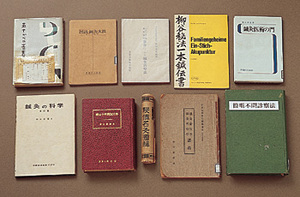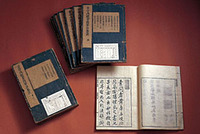Selected Works of Yanagiya Sorei and His Last Wishes
Sorei Yanagiya’s Writings
 『秘法一本鍼伝書』Mippou ippon-shin densho (lit. “A Guide to Secret Techniques of Single Needle Acupuncture”)
『秘法一本鍼伝書』Mippou ippon-shin densho (lit. “A Guide to Secret Techniques of Single Needle Acupuncture”)
『最新鍼灸医学摘要』Saishin shinkyuu igaku tekiyou (lit. “A Summary of the Newest Developments in the Medicine of Acupuncture and Moxibustion”)
『秘伝名灸図解』Hiden meikyuu zukai (lit. “An Illustrated Guide to Important Moxibustion Esoterica”)
『鍼灸医術の門』Shinkyuu ijutsu no mon (lit. “Introduction to the Medical Arts of Acupuncture and Moxibustion”)
『図解鍼灸実技』Zukai Shinkyuu Jitsugi(lit. “Illustrated Techniques of Acupuncture and Moxibustion)
『校訂十四経兪穴学』Koutei juuyon-kei yuuketsugaku (lit. “The Phasic Point Theory of the Fourteen Meridians: Revised Edition”)
『図解按摩術』Zukai anma-jutsu (lit. “Illustrated Anma Massage Techniques”)
『五十からの青春』Gojuu kara no seishun (lit. “Youth Starts at Fifty”)
『鍼灸の科学』Shinkyuu no kagaku (lit. “The Science of Acupuncture and Moxibustion”)
『合類鍼灸医科学』Gourui shinkyuu ikagaku (lit. “A Compendium of Similar Acupuncture and Moxibustion Medical Arts”)
『禁穴論返し鍼法』Kinketsuron kaeshibari-hou (lit. “Forbidden Acupoints and Methods for Dealing with Adverse Acupuncture Reactions”)
『簡明不問診察法』Kanmei fumon shinsatsu-hou (lit. “Concise Medical Examination without Patient Histories”)
『小児絶対健康法』Shouni zettai kenkou-hou(lit. “Method of Absolute Health for Children”
『補瀉論集』Ho sha ronshuu (lit. “Collected Writings on Reinforcing and Reducing”)
『鍼灸治療医典』Shinkyuu chiryou iten (lit. “Medical Dictionary of Acupuncture and Moxibustion Treatments”)
『強壮灸と治療灸』Kyousou-kyuu to chiryou-kyuu (lit. “Tonic Moxibustion and Healing Moxibustion”)
『八木下九十翁実験実証/脈診による鍼灸治療法』Yagishita kyuujuu-ou jikken jisshou/myakushin ni yoru shinkyuu chiryou-hou (lit. “Pulse Diagnosis Based Acupuncture and Moxibustion Treatment Methods: Experiments and Validation of Ninety Yagishita Treatments”)
『註解黄帝内経霊枢(九巻)』Chuukai koutei daikei reisu (kyuu maki) (lit. “Annotated Lingshu (Jiujuan) of the Huangdi Neijing”)
『鍼灸兪穴学治療学講義』Shinkyuu yuuketsugaku chiryou-gaku kougi (lit. “Lectures on Acupuncture and Moxibustion: Phasic Points and Treatment Theory”)
『鍼灸医学全書(全4册)』Shinkyuu igaku zensho(zen yon satsu) (lit. “Encyclopedia of the Medicine of Acupuncture and Moxibustion (Four Volumes)”)
… and many other works..
Selected Works of Yanagiya Sorei and His Last Wishes
“Acupuncture and moxibustion should return to the Classics, pursue facts, and possess a spirit of clinical experimentation. Thus, we can examine and reappraise the theory contained within the Classics, where treasures are interspersed with dross. We should formulate theory that is genuinely useful in clinical settings and, moreover, seek to establish this theory scientifically.”
Starting in 1935, Toyoshinkyu founder Sorei Yanagiya submitted articles to many publications containing phrasing similar to the above. Spreading this manifesto, he made progress in improving the medicine of acupuncture and moxibustion.
Although Yanagiya continually stated the importance of elucidating acupuncture and moxibustion academically, in fact he placed even more importance on transmitting and developing the traditional acupuncture and moxibustion techniques of Japan and China. His objective was the continuation and expansion of the development of authentic techniques (including psychological techniques) useful in clinical applications. This is evident in the following quote from Yanagiya:
“Despite this, acupuncture and moxibustion are an ‘art.’ There can be no development separate from this ‘art.’ It may be that acupuncture and moxibustion divorced from art and skill could become a set of techniques continued under the pretext of science. It may be that a so-called scientific transformation might take place. However, that would be an acupuncture and moxibustion drained of its essential energy. Even if this empty interpretation of the theory of acupuncture and moxibustion were to exist, it would be impossible for this hollow creature to give birth to future acupuncture and moxibustion.” (from the “Shinkyu no risou (Ideals of Acupuncture and Moxibustion)” prologue to the February 1940 edition of Ido no Nippon)
Sorei Yanagiya also commented on the difficulty of acquiring technique. In order to make techniques your own, he advocated for sufficient time spent immersed in practicing the step-by-step training methods handed down from generation to generation, emphasizing the importance of constant practice to make a technique your own.
“The art of acupuncture is to insert a straight object into a living organism and produce a diverse variety of responses by twisting, turning, raising, and lowering this object vertically and horizontally. Modern acupuncture emphasizes solely the strength or weakness of stimulation; I sense there is a trend to pay too little attention to the nature of the condition being treated. Perhaps this is one reason people are unable to achieve a level of technique that is more nuanced.” (from the “Shinkyu no myoumi (Subtle Techniques of Acupuncture and Moxibustion)” prologue to the March 1939 edition of Ido no Nippon)
“A single acupuncture needle can cure acute ailments and a single moxibustion cone can cure long lasting conditions. A genuine application of the Tao of acupuncture of moxibustion is absolutely impossible without achievement of true mastery.” (from the “Shinkyu-dou no shinzui (The Essence of the Tao of Acupuncture and Moxibustion)” prologue to the February 1941 edition of Ido no Nippon)
“The now deceased Kodo Yoshida would admonish his students, strictly declaring that they needed to practice everyday, even if that practice was a single needle inserted into their own thighs. Turning our gaze on the current educational environment reveals that we are now reduced to a state of neglect of acupuncture practice: a neglect of practice inserting needles into living beings and practice penetrating hard objects and lute strings, not to mention the negligence of practice on floating objects. Naturally, at the current levels of practice it is not possible to freely command delicate and precise needles. This reality is where my thoughts are mired. Despite this, I am unable to stop hoping for acupuncturists who have futures of great growth and activity.” (from the “Shugi no shuugyou (Training in Technique)” prologue to the October 1953 edition of Ido no Nippon)

Furthermore, Yanagiya believed possessing a good awareness of the body was important in order to accurately determine acupoints. As such, he emphasized the value of anma massage experience in addition to a comprehensive knowledge of modern medicine. It was his belief that performing anma massage daily on the human body provides a detailed acquaintance with the body as a whole, giving the practitioner knowledge of when the body is normal (healthy) and abnormal (diseased). Only once this skill is developed will it become possible to discover points on the body that present abnormal reactions.
Academic learning and practical skills are like the paired wheels of a car. One should not be emphasized while the other is ignored. Instead, it is important to seek balance. This is true for acupuncture and moxibustion as well. Looking at the current state of acupuncture and moxibustion education reveals a trend towards the academic, with genuine clinical aspects often alienated. At Toyoshinkyu, we believe it is a continuation of the will of our founder to not only work for a balance between academic learning and practical skills, but also strive for education that emphasizes technique, fostering individuals who can contribute to the continuation and development of traditional acupuncture and moxibustion skills.


